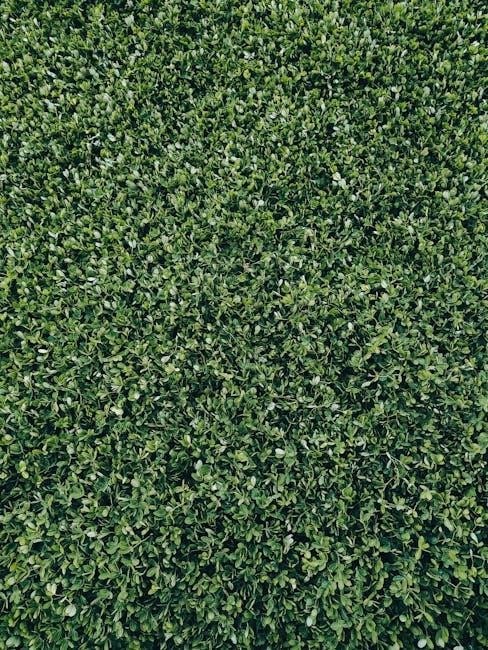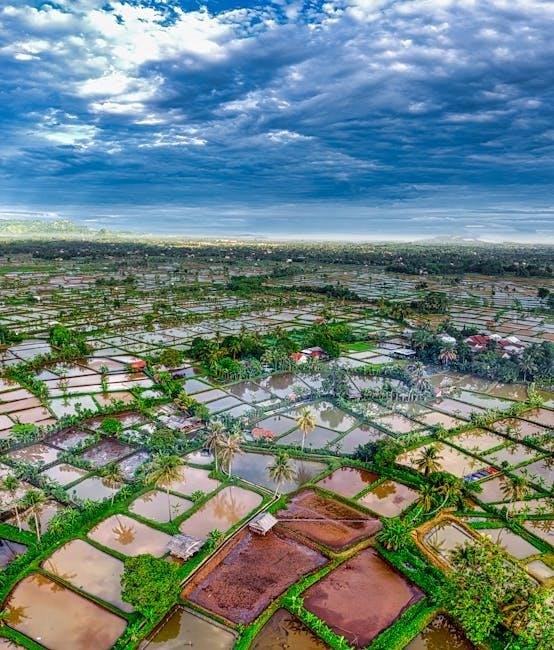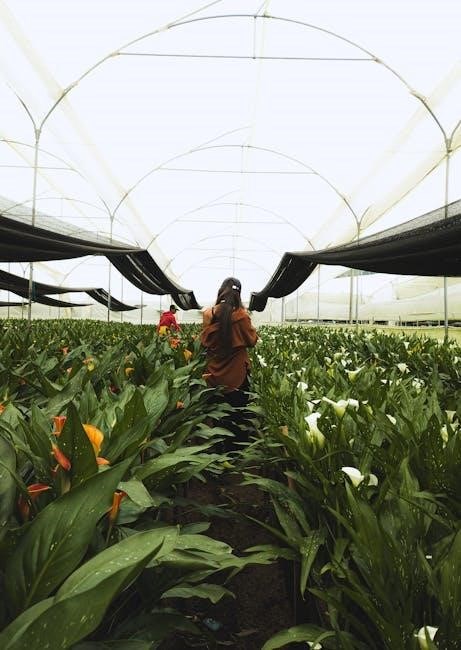Understanding USDA Hardiness Zone 8a
USDA Hardiness Zone 8a has average minimum temperatures of 10°F to 15°F (-12°C to -9°C). It features moderate winters and warm summers, with a long growing season.

What is Hardiness Zone 8a?
USDA Hardiness Zone 8a is a specific geographic area defined by its average minimum winter temperatures, ranging from 10°F to 15°F (-12°C to -9°C). This classification helps gardeners and growers determine which plants are most likely to thrive in their local climate. Zone 8a experiences moderate winters and warm, long summers, making it suitable for a wide variety of plants. The USDA Hardiness Zone Map is a crucial tool for understanding regional planting conditions and selecting appropriate flora. This zone is particularly favorable for plants that prefer mild winters and can tolerate hot summers. Understanding your hardiness zone is essential for successful gardening, as it guides decisions on plant selection, planting times, and care strategies.
Climate Characteristics of Zone 8a
Zone 8a is characterized by mild winters, with average minimum temperatures ranging from 10°F to 15°F (-12°C to -9°C). The growing season is long, typically lasting from late winter to early fall. Summers are warm to hot, with temperatures often reaching 90°F (32°C) or higher. The last frost date is generally around April 1st, while the first frost occurs near December 1st. This climate supports a wide range of plants, as the moderate winters allow for year-round growth with proper planning. Additionally, Zone 8a often experiences moderate humidity, which can influence planting strategies and soil conditions. Understanding these climate characteristics is crucial for optimizing plant selection and timing in your garden.
Best Plants for Zone 8a
Zone 8a supports a wide variety of vegetables, fruits, flowers, and herbs. The long growing season allows for multiple harvests of crops like tomatoes, peppers, and leafy greens.
Vegetables Suitable for Zone 8a
Zone 8a’s long growing season supports a wide variety of vegetables. Cool-season crops like broccoli, cauliflower, and spinach thrive in early spring, while warm-season crops such as tomatoes, peppers, and eggplant excel in summer. Root vegetables like carrots, beets, and radishes grow well in Zone 8a’s climate. Leafy greens, such as kale and lettuce, can be planted in both spring and fall. Succession planting is key to maximizing yields, allowing gardeners to enjoy continuous harvests. With proper planning, Zone 8a gardeners can grow vegetables nearly year-round, taking advantage of the region’s favorable conditions and extended growing season.
Fruits, Flowers, and Herbs for Zone 8a
Zone 8a is ideal for growing a variety of fruits, flowers, and herbs; Fruits like strawberries, blueberries, raspberries, and blackberries thrive in its climate. Citrus trees, such as dwarf varieties of oranges and lemons, also grow well. Avocado trees are popular in Zone 8a, especially when protected from extreme cold snaps. Flowers like roses, lavender, and sunflowers flourish, adding vibrant colors to gardens. Herbs such as rosemary, thyme, and oregano are perfect for year-round growth. Lavender, in particular, thrives in Zone 8a’s warm summers and mild winters. These plants benefit from the region’s long growing season and moderate winters, making it a versatile zone for diverse gardening interests.

Planting Seasons in Zone 8a
Zone 8a has a long growing season, with a last frost date around April 1st and first frost date near December 1st, allowing for year-round planting opportunities.
Frost Dates and Growing Season
In Zone 8a, the last frost date is typically around April 1st, and the first frost date occurs near December 1st. This results in a long growing season of approximately 270 days. Gardeners can start planting cool-season crops like broccoli and spinach as early as February. Warm-season crops, such as tomatoes and peppers, should be planted after the last frost date. The extended growing season allows for multiple harvests, including a fall garden. Planting in late summer ensures a second crop of cool-season vegetables before the first frost. Monitoring local weather conditions is essential for precise planting and harvesting timelines to maximize yields. This climate offers ideal conditions for a diverse and productive garden year-round. Proper planning based on these dates is crucial for success.
When to Start Planting in Zone 8a
In Zone 8a, planting begins with cool-season crops like spinach and broccoli as early as February. Warm-season crops such as tomatoes and peppers should be planted after the last frost date, around April 1st. Succession planting every few weeks ensures continuous harvests. Starting seeds indoors 4-6 weeks before the last frost date benefits plants like tomatoes. Soil temperature is key for germination, with warm-season crops needing warmer soil. Additionally, fall planting in late summer for crops like kale and Brussels sprouts can yield a winter harvest. Proper timing and strategies maximize the long growing season in Zone 8a, allowing gardeners to enjoy a diverse and productive garden year-round.

Soil Preparation in Zone 8a
Soil preparation in Zone 8a involves enhancing fertility and drainage. Amend with compost or mulch to improve soil structure and promote healthy root growth throughout the season.
Soil Types and Amendments for Zone 8a
Zone 8a typically features diverse soil types, including sandy, loamy, and clay soils. To optimize growth, amend soils with organic matter like compost or well-rotted manure to improve structure and fertility. For sandy soils, add compost to retain moisture and nutrients. Clay soils benefit from mulch or straw to enhance drainage and aeration. Balancing soil pH is crucial, as most plants thrive in slightly acidic to neutral conditions (6.0–7.5). Regular mulching helps retain moisture and suppress weeds. Avoid over-amending, as this can disrupt soil balance. Testing soil annually ensures proper nutrient levels and pH adjustments. These practices create a fertile foundation for robust plant growth in Zone 8a’s climate.
Optimizing Soil for Maximum Yield

To maximize yield in Zone 8a, focus on creating balanced, nutrient-rich soil. Crop rotation is essential to maintain soil health and prevent nutrient depletion. Incorporate compost or aged manure to enhance organic matter, improving soil structure and fertility. Mulching helps retain moisture and suppress weeds, while timely fertilization ensures plants receive essential nutrients. For vegetables like tomatoes and squash, side-dress with calcium-rich fertilizers to prevent blossom-end rot. Rotate nitrogen-fixing legumes with heavy feeders to maintain soil balance. Regularly test soil pH and adjust as needed, as most crops thrive in a slightly acidic to neutral range (6.0–7.5). Proper irrigation and drainage are also critical to avoid waterlogged soil. By optimizing these practices, gardeners in Zone 8a can achieve abundant harvests and vibrant plant growth.
Common Challenges in Zone 8a

Zone 8a gardeners face challenges like intense heatwaves, occasional droughts, and pests such as aphids and nematodes. Soil depletion and nutrient imbalances can also affect plant health.
Dealing with Extreme Weather Conditions
Gardeners in Zone 8a often contend with intense heatwaves, droughts, and occasional frosts. To mitigate these, use drought-resistant plants, mulch to retain soil moisture, and water deeply during dry spells. For heat protection, apply shade cloth during peak sun hours and avoid overhead watering, which can exacerbate evaporation. During unexpected frosts, cover sensitive plants with frost blankets or bring potted plants indoors. Regular soil conditioning and proper irrigation schedules can help plants withstand extreme conditions. Monitoring weather forecasts and adapting planting schedules accordingly is crucial for a resilient garden in Zone 8a.
Pests and Diseases in Zone 8a
Gardening in Zone 8a requires vigilance against pests like aphids, whiteflies, and spider mites, which thrive in the warm climate. Regularly inspect plants and use neem oil or insecticidal soap for control. Root rot and powdery mildew are common diseases, often caused by overwatering or poor air circulation. Implement crop rotation, remove infected plant parts, and treat with fungicides if necessary. Encourage beneficial insects like ladybugs and lacewings to maintain a balanced ecosystem. Proper watering practices and soil health are key to preventing these issues. Monitor plants frequently and act early to prevent infestations or infections from spreading, ensuring a healthy and productive garden in Zone 8a.
Planting Guide by Month
Zone 8a offers a long growing season. Start seeds indoors in January, transition to outdoor planting by March, and continue through summer. Fall and winter crops thrive starting in August and October, ensuring year-round harvesting opportunities for gardeners.
Spring Planting in Zone 8a
Spring planting in Zone 8a begins in late winter to early spring, with cool-season crops like broccoli, cauliflower, and spinach thriving in cooler temperatures. Start seeds indoors in January for an early March transplant. By February, prepare soil and sow root vegetables such as carrots and radishes directly outdoors. As temperatures rise, transition to warm-season crops like tomatoes and peppers in late March or early April. Ensure to monitor frost dates, as the last frost typically occurs around April 1st. Spring is also ideal for planting flower bulbs and herbs like lavender, which tolerate Zone 8a’s climate. Proper soil preparation and succession planting will maximize your garden’s productivity throughout the season.
Summer, Fall, and Winter Planting
In Zone 8a, summer planting focuses on heat-tolerant crops like cantaloupe, watermelon, and eggplant, which thrive from May to July. Herbs such as basil and rosemary also excel. Fall planting begins in late summer, with broccoli, spinach, and lettuce maturing before the first frost in December. Winter planting is possible due to mild temperatures, with spinach, kale, and root vegetables like carrots growing well. Succession planting and frost protection, like blankets, extend the growing season. Year-round gardening is feasible in Zone 8a, making it ideal for diverse and continuous harvests.

Additional Resources
- Kellogg Garden Zone Planting Charts provide detailed guides for Zone 8a.
- Local nurseries offer region-specific advice and materials.
- USDA Plant Hardiness Zone Map and local gardening communities are excellent resources for Zone 8a gardeners.
Zone 8a Planting Charts and Calendars
Zone 8a planting charts and calendars are essential tools for gardeners, providing detailed guidance on when to sow seeds, transplant, and harvest. These resources outline specific planting dates for vegetables, fruits, and herbs, ensuring optimal growth. Charts often include information on cool-season and warm-season crops, such as broccoli, cauliflower, and tomatoes. Visual calendars offer month-by-month recommendations, helping gardeners plan effectively; Many charts also account for Zone 8a’s average frost dates, typically around April 1st for the last spring frost and December 1st for the first fall frost. By following these guides, gardeners can maximize their growing season and enjoy a bountiful harvest. Local nurseries and online resources like the Kellogg Garden Zone Planting Charts are reliable sources for Zone 8a-specific planting schedules.
Local Nurseries and Gardening Communities
Local nurseries and gardening communities in Zone 8a are invaluable resources for gardeners. These establishments offer plants tailored to the region’s climate and soil conditions, ensuring success for gardeners. Many nurseries provide expert advice on selecting the best varieties for Zone 8a, from vegetables to flowers. Gardening communities, both online and in-person, connect gardeners, fostering knowledge sharing and support. They often host workshops, seed exchanges, and events focused on Zone 8a-specific challenges and opportunities. Joining these groups allows gardeners to learn from experienced growers, gain insights into local microclimates, and access planting guides adapted to their area. This collective expertise helps gardeners thrive in Zone 8a’s unique growing conditions.



